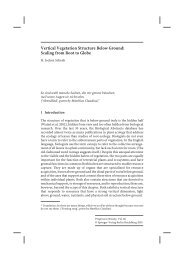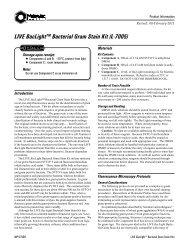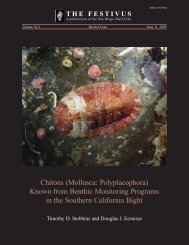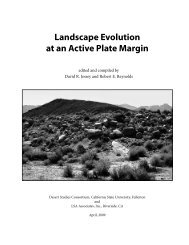2010 Overboard in the Mojave - Biological Science - California State ...
2010 Overboard in the Mojave - Biological Science - California State ...
2010 Overboard in the Mojave - Biological Science - California State ...
Create successful ePaper yourself
Turn your PDF publications into a flip-book with our unique Google optimized e-Paper software.
to have been susta<strong>in</strong>ed by extreme w<strong>in</strong>ter storms <strong>in</strong> <strong>the</strong><br />
headwaters that persisted over years to decades (Enzel<br />
et al., 1992; Enzel and Wells, 1997). Enzel et al. (2003)<br />
<strong>in</strong>ferred that susta<strong>in</strong><strong>in</strong>g a lake dur<strong>in</strong>g <strong>the</strong> late Pleistocene,<br />
when evaporation rates were reduced and transmission<br />
losses to groundwater may have been lower, would have<br />
required an average annual discharge at least an order of<br />
magnitude larger than today. Although Lake Manix was<br />
far<strong>the</strong>r upstream <strong>in</strong> <strong>the</strong> fluvial system than <strong>the</strong> younger<br />
Lake <strong>Mojave</strong> studied by Enzel et al., and likely had lower<br />
transmission losses as a result, river <strong>in</strong>puts that susta<strong>in</strong>ed<br />
Lake Manix were almost certa<strong>in</strong>ly highly variable. Prelim<strong>in</strong>ary<br />
results from outcrop study and from analysis of<br />
sedimentology and stable isotopes <strong>in</strong> <strong>the</strong> U.S. Geological<br />
Survey (USGS) Manix core (Reheis et al., 2009a, b)<br />
suggest large variability <strong>in</strong> lake level on timescales rang<strong>in</strong>g<br />
from possibly seasonal to millennial. Variable river <strong>in</strong>put,<br />
comb<strong>in</strong>ed with relatively high evaporation rates <strong>in</strong> this<br />
low-desert sett<strong>in</strong>g (Meyers, 1962), would have caused<br />
lake level to fluctuate cont<strong>in</strong>ually and would have created<br />
dynamic and generally unstable nearshore environments.<br />
The general history of Lake Manix was established by<br />
Jefferson and Meek (Ellsworth, 1932; Meek, 1990, 2000;<br />
Jefferson, 2003; Meek, 2004), and our recent mapp<strong>in</strong>g,<br />
stratigraphic studies, and dat<strong>in</strong>g (Miller and McGeeh<strong>in</strong>,<br />
2007; Reheis et al., 2007b; Reheis and Redw<strong>in</strong>e, 2008;<br />
Reheis et al., 2009a, 2009b) have added much new<br />
<strong>in</strong>formation. The Manix bas<strong>in</strong> conta<strong>in</strong>s a spectacularly<br />
well-exposed record of lake fluctuations <strong>in</strong> sett<strong>in</strong>gs that<br />
are somewhat atypical for Great Bas<strong>in</strong> pluvial lakes, <strong>in</strong><br />
that <strong>the</strong> sediments <strong>in</strong>clude extensive low-gradient fluvialdeltaic<br />
and mudflat deposits, as well as ephemeral alluvialfan–lake-marg<strong>in</strong>al<br />
deposits. The exposures are unusual<br />
because <strong>the</strong> lake dra<strong>in</strong>ed by threshold failure, with stream<br />
flow eventually cutt<strong>in</strong>g <strong>in</strong>to <strong>the</strong> floor of <strong>the</strong> lake, <strong>in</strong>cis<strong>in</strong>g<br />
lake and alluvial deposits <strong>in</strong> a wide variety of geomorphic<br />
sett<strong>in</strong>gs. The purpose of this short paper is to characterize<br />
and provide examples of <strong>the</strong> nearshore environments<br />
of deposition of Lake Manix, to aid <strong>in</strong> <strong>the</strong>ir recognition<br />
<strong>in</strong> o<strong>the</strong>r sett<strong>in</strong>gs and <strong>in</strong> <strong>the</strong> geologic record. We make<br />
no attempt to provide detailed sedimentologic or stratigraphic<br />
characteristics or to adopt formal bas<strong>in</strong>-analysis<br />
procedures, as <strong>the</strong>se are abundantly well documented <strong>in</strong><br />
textbooks (e.g., Read<strong>in</strong>g and Coll<strong>in</strong>son, 1996; Talbot and<br />
Allen, 1996; Komar, 1998) and research papers. Ra<strong>the</strong>r,<br />
our <strong>in</strong>tent is to po<strong>in</strong>t out some unique depositional features<br />
of this low-desert, fluvially controlled paleolake.<br />
Nearshore environments of Lake Manix<br />
Throughout <strong>the</strong> geologic history of Lake Manix, <strong>the</strong> lake<br />
<strong>in</strong>teracted with a variety of depositional sett<strong>in</strong>gs <strong>in</strong>flu-<br />
m. c. reheis and d. m. miller<br />
enced by proximity to <strong>the</strong> <strong>Mojave</strong> River, <strong>the</strong> amount of<br />
alluvial activity, surface slope, and bas<strong>in</strong> configuration.<br />
There was an abrupt contrast <strong>in</strong> sedimentary environments<br />
near <strong>the</strong> migrat<strong>in</strong>g mouth of <strong>the</strong> <strong>Mojave</strong> River and<br />
<strong>the</strong> rest of <strong>the</strong> bas<strong>in</strong>’s marg<strong>in</strong>s, which are alluvial fans, <strong>in</strong><br />
places mantled by or <strong>in</strong>terbedded with eolian deposits.<br />
The Manix bas<strong>in</strong> consists of four <strong>in</strong>terl<strong>in</strong>ked subbas<strong>in</strong>s<br />
(Fig. 2). Although all of <strong>the</strong>se subbas<strong>in</strong>s are traversed by<br />
faults, some of <strong>the</strong>m active as recently as <strong>the</strong> Holocene,<br />
<strong>the</strong>ir marg<strong>in</strong>s are not fault-bounded; hence, most of <strong>the</strong><br />
nearshore environments are characterized by fluvial, alluvial-fan,<br />
and locally, eolian sediments. Three exceptions<br />
of steep topography adjacent to <strong>the</strong> lake are (1) <strong>the</strong> south<br />
face of Buwalda Ridge, which is underla<strong>in</strong> by a Pliocene<br />
fanglomerate that is bounded by <strong>the</strong> Manix fault, (2) <strong>the</strong><br />
north face of Soldier Mounta<strong>in</strong>, and (3) <strong>the</strong> eastern end<br />
of <strong>the</strong> Afton subbas<strong>in</strong>, where <strong>the</strong> lake abutted <strong>the</strong> bedrock<br />
of Shorel<strong>in</strong>e Hill and slopes to <strong>the</strong> south. The Cady and<br />
Troy Lake subbas<strong>in</strong>s lay nearest <strong>the</strong> entry po<strong>in</strong>t of <strong>the</strong><br />
<strong>Mojave</strong> River, and thus <strong>the</strong>ir sediments record <strong>in</strong>teraction<br />
of <strong>the</strong> lake with <strong>the</strong> encroach<strong>in</strong>g fluvial fan of <strong>the</strong> <strong>Mojave</strong><br />
River, as well as with alluvial fans of local dra<strong>in</strong>ages. The<br />
Coyote Lake subbas<strong>in</strong>, surrounded by alluvial fans, is<br />
separated by a shallow bedrock sill from <strong>the</strong> Cady subbas<strong>in</strong><br />
(Meek, 1990, 1994), and hence served as a release<br />
valve for high lake levels <strong>in</strong> <strong>the</strong> rest of <strong>the</strong> Manix bas<strong>in</strong>. As<br />
such, Coyote Lake was shallow or even dry dur<strong>in</strong>g part<br />
of <strong>the</strong> history of Lake Manix. The Afton subbas<strong>in</strong> is most<br />
distant from <strong>the</strong> <strong>Mojave</strong> River <strong>in</strong>let, and is bounded on<br />
<strong>the</strong> north and south by alluvial fans. On <strong>the</strong> east end, this<br />
subbas<strong>in</strong> is characterized by steep marg<strong>in</strong>s with relatively<br />
high-gradient fans and bedrock. The Afton subbas<strong>in</strong> was<br />
abruptly <strong>in</strong>tegrated <strong>in</strong>to Lake Manix shortly before <strong>the</strong><br />
deposition of <strong>the</strong> Manix tephra (Reheis et al., 2007b;<br />
Reheis et al., 2009a) at about 185 ka ( Jefferson, 2003).<br />
The nearshore depositional environments of Lake<br />
Manix are subdivided on <strong>the</strong> basis of adjacent deposits<br />
and <strong>the</strong>ir gradients as follows: (1) deltaic, <strong>in</strong>teract<strong>in</strong>g with<br />
fluvial <strong>in</strong>puts of <strong>the</strong> <strong>Mojave</strong> River, ei<strong>the</strong>r proximal or distal<br />
to <strong>the</strong> river mouth; (2) <strong>in</strong>teract<strong>in</strong>g with active alluvial<br />
fan channels of ei<strong>the</strong>r gentle or moderate to steep gradients;<br />
(3) <strong>in</strong>teract<strong>in</strong>g with alluvial-fan deposits with no<br />
active channels, with gentle or moderate gradients; and<br />
(4) <strong>in</strong>teract<strong>in</strong>g with colluvium and very steep fans along<br />
mounta<strong>in</strong> fronts. These <strong>in</strong>teractions resulted <strong>in</strong> characteristic<br />
suites of sediments and stratigraphic architectures,<br />
many of which of course overlap among <strong>the</strong>se groups.<br />
One reliable <strong>in</strong>dicator of nearshore environments <strong>in</strong><br />
Lake Manix is <strong>the</strong> presence of stromatolitic carbonatecoated<br />
clasts, termed “oncoids” by Awramik et al. (2000).<br />
These coats consist of relatively dense, commonly lam<strong>in</strong>ar,<br />
s<strong>in</strong>gle to multiple, wavy layers rang<strong>in</strong>g from
















